Chair yoga offers you accessible poses that enhance physical stability and mental well-being as you age. You’ll practice seated mountain pose for grounding, cat-cow stretches for spinal flexibility, and forward bends for relaxation. Add seated twists for digestive health, hip openers for lower body mobility, and leg extensions for strength. Include ankle rolls for joint circulation and coherent breathing techniques for mindful awareness. These gentle movements help prevent falls while promoting independence and cognitive function through mindful movement practices.
Seated Mountain Pose for Grounding and Stability
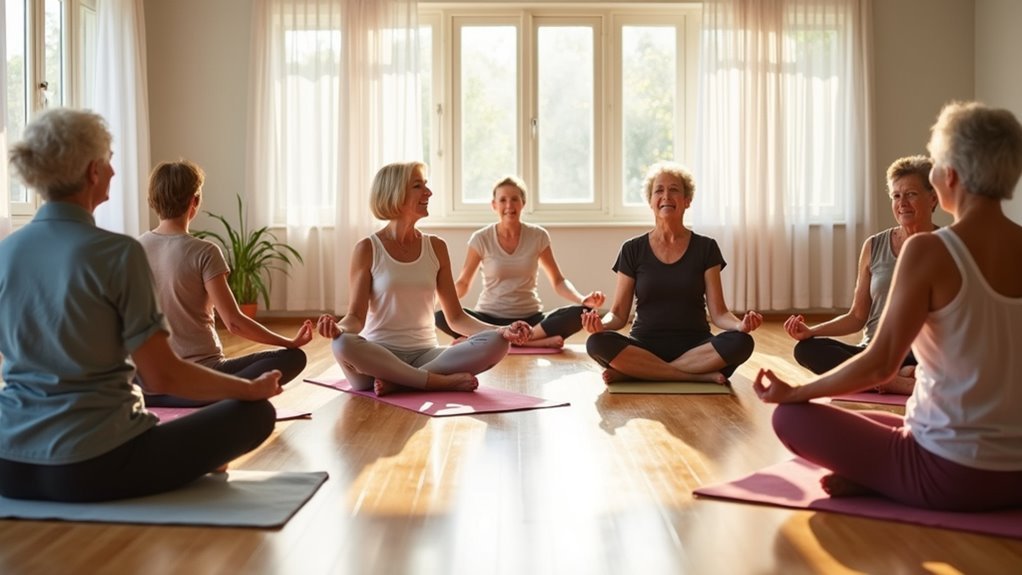
Foundation matters in yoga, and Seated Mountain Pose delivers exactly that for chair-based practice.
You’ll sit tall with feet flat on the floor while engaging your core muscles to establish grounding and stability. This fundamental position among Chair Yoga Poses promotes proper posture, directly enhancing your balance and reducing fall risk—crucial since one in three seniors experience falls annually.
Focus on alignment while taking several deep breaths in Seated Mountain Pose. This breath awareness promotes relaxation and supports your mental well-being.
Deep breathing in Seated Mountain Pose creates a pathway to inner calm and enhanced mental clarity.
You’re building increased body awareness and mindfulness, which positively impacts cognitive function and overall quality of life during mindful aging.
This pose serves as your essential foundation, preparing you to shift smoothly into other seated yoga positions within your chair yoga routine.
Seated Cat-Cow Stretch for Spinal Flexibility
While maintaining your grounded Seated Mountain Pose foundation, you’ll shift into the Seated Cat-Cow Stretch to enhance your spinal flexibility and release built-up tension. This gentle movement alternates between arching and rounding your spine, making it perfect for those with limited mobility who need accessible breathing exercises.
| Movement Phase | Spine Position | Breath Pattern | Key Benefit |
|---|---|---|---|
| Cat Pose | Rounded forward | Exhale slowly | Releases neck tension |
| Cow Pose | Arched backward | Inhale deeply | Opens chest muscles |
| Shift | Neutral return | Natural breath | Coordinates movement |
| Hold | Either position | Steady breathing | Deepens stretch effect |
Regular practice improves your posture while reducing fall risks. The coordinated breath-to-movement pattern promotes relaxation and enhances overall spinal mobility, addressing stiffness that commonly affects seniors.
Seated Forward Bend for Relaxation and Release
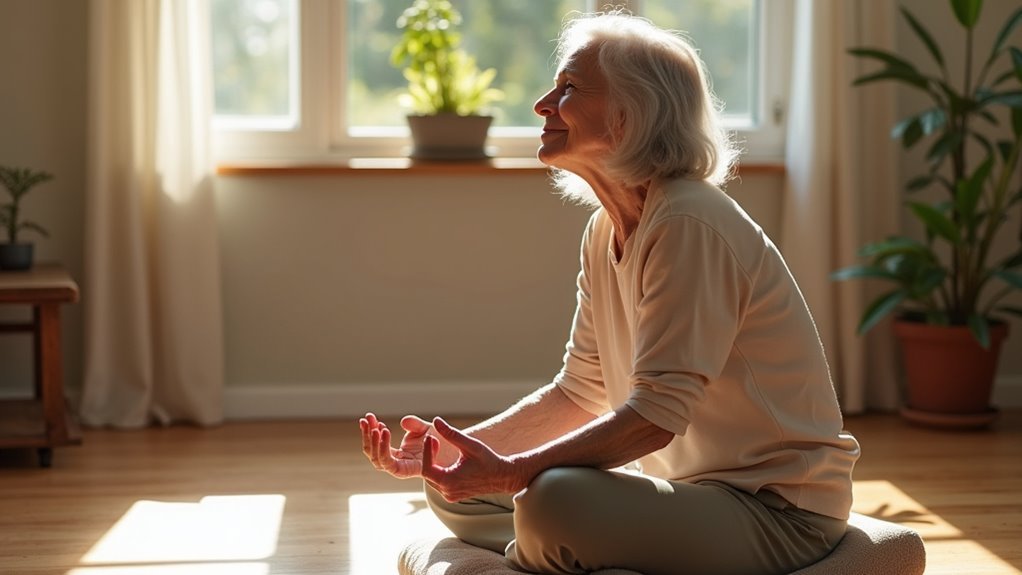
Building on your improved spinal mobility from the Cat-Cow stretch, you’ll shift into the Seated Forward Bend to deepen your relaxation and release accumulated tension throughout your back and shoulders.
Sit with your feet flat on the floor, inhaling to lengthen your spine upward. As you exhale, gently fold forward while keeping your back straight—avoid rounding to prevent strain.
This seated forward bend promotes flexibility in your hamstrings and lower back, supporting daily movement. Hold for several breaths, allowing deep breathing to gradually release muscle tightness.
Focus on your breath and mindfulness during this movement. Regular practice enhances mental clarity and calmness while improving overall mobility essential for aging gracefully.
Seated Side Stretch for Lateral Mobility
When you practice the seated side stretch, you’ll want to focus on maintaining proper spinal alignment by sitting tall and keeping your hips firmly grounded in the chair.
As you extend one arm overhead and lean gently to the opposite side, coordinate your movement with deep, mindful breathing to maximize the stretch’s benefits.
You’ll find that breathing deeply into the extended side helps open the intercostal muscles while promoting relaxation throughout the entire movement.
Proper Alignment Techniques
As you settle into the Seated Side Stretch, maintaining proper alignment becomes essential for maximizing lateral mobility while protecting your spine. These proper alignment techniques guarantee you’re getting the most from this gentle yet effective movement.
| Body Part | Proper Position | Common Mistake | Correction |
|---|---|---|---|
| Hips | Grounded and stable | Lifting or shifting | Press both hips down firmly |
| Spine | Elongated and tall | Leaning forward | Keep chest open, reach up first |
| Shoulders | Relaxed and away from ears | Hunched or tense | Actively drop shoulders down |
| Core | Gently engaged | Completely relaxed | Activate deep abdominals |
Engaging your core while maintaining these positions will enhance lateral mobility and help you age gracefully. Remember, the Seated Side Stretch becomes more effective when you prioritize alignment over depth of stretch.
Breathing During Stretches
Your breath becomes the bridge between movement and mindfulness during the Seated Side Stretch, transforming a simple mobility exercise into a powerful tool for present-moment awareness.
As you reach one arm overhead, inhale deeply to expand your rib cage and enhance oxygen flow throughout your body. This intentional breathing pattern helps stretch the lateral muscles more effectively while promoting relaxation.
When you lean to the opposite side, exhale gently to release tension and deepen the stretch. This coordinated breathing technique prevents strain in your shoulders and neck while maximizing the pose’s benefits.
Regular practice with mindful breathing improves your posture, spinal alignment, and daily mobility. The calm presence you’ll cultivate through conscious breathing during this stretch can greatly improve mood and support your mindful aging journey.
Seated Twist for Digestive Health and Spinal Movement
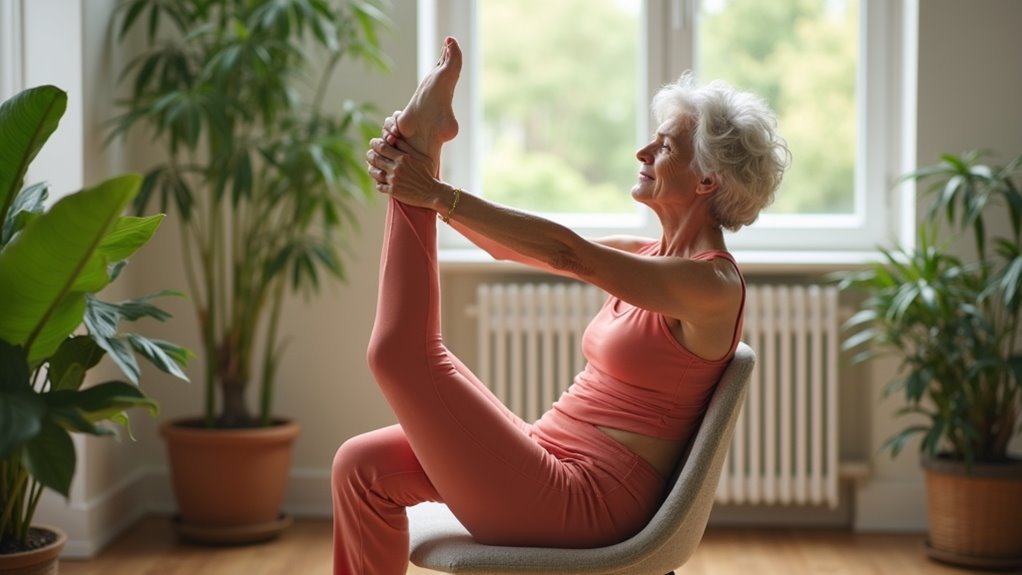
While maintaining proper posture becomes increasingly challenging with age, the Seated Twist offers a gentle yet effective solution for enhancing spinal mobility and digestive wellness.
This chair yoga pose encourages rotation of your spine, alleviating back tension while improving overall posture. You’ll stimulate digestive organs and enhance abdominal circulation, potentially relieving constipation issues.
Regular practice increases spinal flexibility, making daily movements easier and reducing injury risk. Since you can perform this seated twist in any sturdy chair, it’s perfect for those with limited mobility.
The gentle twisting motion promotes mindfulness and relaxation, helping reduce stress while boosting mental clarity. This accessible pose makes digestive health and spinal care achievable for everyone, regardless of physical limitations or experience level.
Seated Shoulder Rolls for Upper Body Relief
You’ll find seated shoulder rolls incredibly effective for releasing the tension that builds up in your neck, shoulders, and upper back throughout the day.
The proper technique involves sitting tall while slowly lifting your shoulders toward your ears, then rolling them back and down in a smooth, controlled motion.
This simple movement targets the trapezius and rhomboid muscles, providing immediate relief from stiffness and promoting better circulation in your upper body.
Proper Shoulder Roll Technique
Although shoulder tension affects nearly everyone who spends time sitting, seated shoulder rolls offer a simple yet effective solution that you can practice anywhere.
Begin by sitting with your back straight and arms relaxed at your sides. This foundational position guarantees proper alignment for maximum upper body benefits.
Follow this technique for best results:
- Inhale deeply while lifting your shoulders to shoulder height toward your ears
- Exhale slowly as you roll them back and down in a smooth, controlled motion
- Repeat this movement 5-8 times, focusing on the gentle stretch
This mindful practice counteracts prolonged sitting effects while promoting relaxation.
You’ll notice improved shoulder flexibility and reduced neck stiffness. Regular shoulder rolls enhance mindfulness by connecting breath with movement, making them perfect for stress relief throughout your day.
Tension Release Benefits
When you practice seated shoulder rolls consistently, your upper body experiences immediate tension release as increased blood circulation flows through tight shoulder muscles and surrounding tissues. This simple movement reduces stiffness while improving shoulder mobility that’s essential for maintaining independence in daily activities.
| Tension Release Benefits | Physical Impact |
|---|---|
| Reduced muscle stiffness | Enhanced blood flow |
| Improved posture comfort | Greater range of motion |
| Stress relief through movement | Mental clarity boost |
The rhythmic shoulder rolling motion, paired with deep breathing, creates a powerful relaxation response that extends beyond physical relief. You’ll notice decreased discomfort from prolonged sitting and poor posture. This combination of movement and mindful breathing fosters an enhanced sense of well-being, contributing to improved mood and overall mental clarity throughout your day.
Seated Hip Opener for Lower Body Flexibility
Hip flexibility serves as a cornerstone of mobility throughout your later years, and the seated hip opener provides an accessible way to maintain this essential range of motion.
This gentle pose targets your hip joints specifically, preventing stiffness that can limit daily movements like walking and climbing stairs.
To practice the seated hip opener, sit tall with your feet flat on the ground. Gently open your knees outward while keeping your feet grounded, creating a safe stretch through your hips. Hold for several breaths to allow deeper tension release.
When you practice yoga regularly, you’ll notice improved joint health through:
- Enhanced stability and balance, reducing fall risk
- Better posture from increased hip mobility
- Easier performance of everyday activities
This consistent practice promotes lasting lower body flexibility essential for aging gracefully.
Seated Leg Extensions for Strength and Circulation
Building upon your hip flexibility work, seated leg extensions offer a powerful combination of strength training and circulation enhancement that’s perfectly suited for chair-based practice.
You’ll position yourself with your back straight and feet flat on the floor, then extend one leg straight out while holding briefly before alternating to the other leg. This simple movement targets your quadriceps muscles while stimulating blood flow throughout your lower extremities.
For older adults, these seated leg extensions deliver remarkable benefits beyond basic exercise.
You’ll improve circulation, reducing risks of circulatory complications common in senior years. The enhanced leg strength you’ll develop directly supports better balance and fall prevention.
Regular practice, even just minutes daily, helps manage arthritis symptoms and promotes greater independence in your everyday activities.
Seated Ankle Rolls for Joint Mobility
You’ll find seated ankle rolls are one of the simplest yet most effective exercises for maintaining joint mobility as you age.
The proper technique involves lifting one foot slightly off the ground and rotating your ankle in slow, controlled circles, focusing on both clockwise and counterclockwise movements to maximize circulation and flexibility benefits.
When you integrate this gentle practice into your daily routine, you’re actively supporting your balance, reducing stiffness, and promoting better blood flow throughout your lower legs.
Proper Ankle Roll Technique
Circulation flows more freely through your ankles when you perform seated ankle rolls, a gentle yet effective exercise that targets joint mobility while accommodating physical limitations.
You’ll start by lifting one foot slightly off the ground, then slowly rotate your ankle in smooth, controlled circles. Focus on moving only your ankle joint while keeping your leg stationary.
- Clockwise Direction: Complete 5-8 slow circles, emphasizing the full range of motion
- Counterclockwise Direction: Reverse the movement for another 5-8 circles to balance muscle engagement
- Switch Feet: Lift your ankle over your left leg’s position and repeat the sequence
Regular practice of seated ankle rolls enhances joint mobility and promotes better balance, reducing fall risks through improved proprioception and flexibility.
Circulation and Flexibility Benefits
Beyond the technical execution of ankle rolls lies their remarkable impact on your body’s circulatory system and joint health. When you perform this gentle movement, you’re enhancing blood flow throughout your lower extremities, effectively reducing your risk of circulation-related complications like blood clots.
The continuous rotation helps maintain your ankle’s full range of motion, preserving essential flexibility that often diminishes with age. Regular practice alleviates discomfort in your feet and lower legs, making daily activities considerably more comfortable.
Since you can perform ankle rolls while seated anywhere, you’ll find it easy to incorporate movement throughout your day. Adding this exercise to your yoga routine contributes to improved overall mobility, helping you maintain the independence that’s vital for confident aging.
Daily Practice Integration
When you commit to practicing seated ankle rolls daily, you’re establishing a foundation for sustained joint health that requires minimal time investment yet delivers maximum mobility benefits.
This accessible yoga practice seamlessly integrates into your routine, whether you’re watching television, reading, or taking breaks from desk work. The health benefits extend beyond physical improvements, creating mindful moments that connect body and mind through focused movement and breath awareness.
Consider these integration strategies:
- Morning routine enhancement – Begin each day with gentle ankle rolls to activate circulation and prepare joints for daily activities.
- Workday wellness breaks – Schedule brief sessions throughout your day to counteract prolonged sitting and maintain flexibility.
- Evening wind-down ritual – Use ankle rolls as a calming shift that promotes relaxation while supporting your daily life mobility needs.
Coherent Breathing Techniques for Mindful Awareness
As you settle into your chair for yoga practice, coherent breathing becomes your gateway to deeper mindfulness and enhanced body awareness. This technique involves slow, rhythmic breaths that help you relax while fostering emotional regulation and mental clarity.
Practice coherent breathing by inhaling for 4-6 seconds, then exhaling for the same duration. You’ll notice your heart rate and blood pressure naturally decrease, promoting cardiovascular health. This breathing pattern enhances your mind-body connection during chair yoga, creating profound calm and awareness.
| Breath Phase | Count | Focus | Benefit |
|---|---|---|---|
| Inhale | 4-6 seconds | Chest expansion | Oxygen intake |
| Hold | 1-2 seconds | Stillness | Mindful pause |
| Exhale | 4-6 seconds | Release tension | Stress reduction |
| Rest | 1-2 seconds | Body awareness | Integration |
| Repeat | 5-10 cycles | Present moment | Enhanced well-being |
Regular practice manages anxiety, improves mood, and supports mindful aging.
Frequently Asked Questions
Does Chair Yoga Really Work for Seniors?
Yes, chair yoga works effectively for you as a senior. You’ll experience improved balance, reduced fall risk, better mental health, enhanced mobility, and decreased anxiety. It’s safe, adaptable to your abilities, and provides mindful movement benefits.
Can You Lose Weight Doing Chair Yoga for Seniors?
You can lose some weight doing chair yoga, but it’s not dramatic. You’ll burn calories through gentle movements, build muscle strength, and reduce stress-related eating, supporting overall weight management effectively.
What Is the Best Chair Yoga App for Seniors Free?
You’ll find “Yoga for Seniors” excellent for gentle stretches and mindfulness. “Chair Yoga with Sherry” emphasizes safety with instructional videos. “Daily Yoga” offers personalized filtering, while “Simply Yoga” provides beginner-friendly sessions.
How Often Should Seniors Do Chair Yoga?
You should practice chair yoga 2-3 times weekly for ideal benefits. Sessions can last 30-60 minutes, or you’ll find daily 10-15 minute practices helpful too. Always listen to your body’s needs.
In Summary
You’ve now discovered nine powerful chair yoga poses that’ll support your journey toward mindful aging. These gentle movements strengthen your body, enhance flexibility, and cultivate inner awareness without requiring you to get on the floor. Practice these poses regularly, listening to your body’s wisdom and moving at your own pace. Remember, consistency matters more than perfection. You’re investing in your long-term health, mobility, and well-being through these simple yet transformative practices.


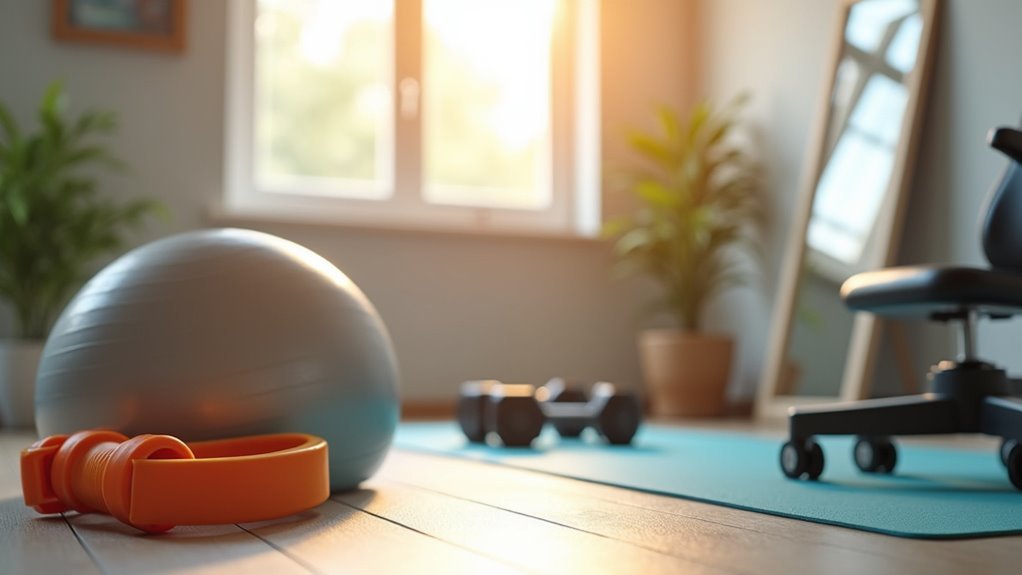
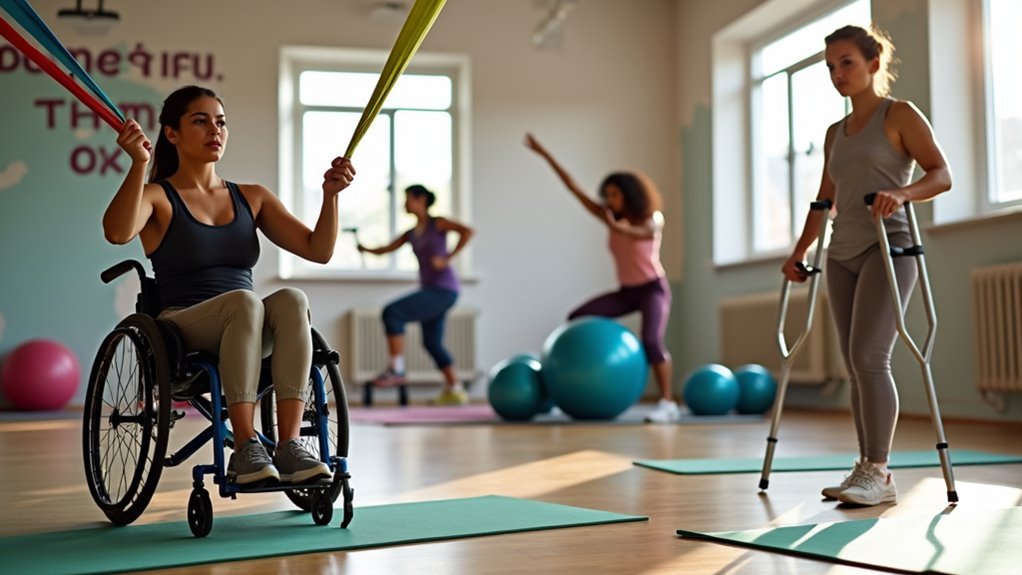
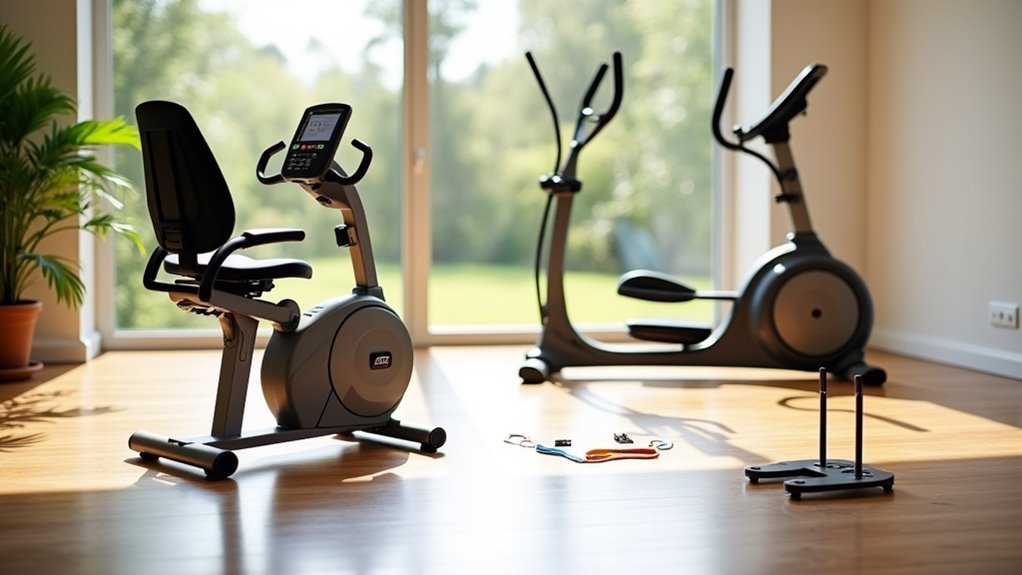
Leave a Reply